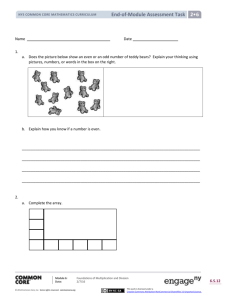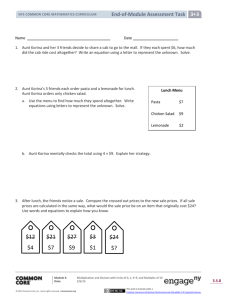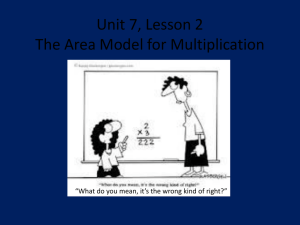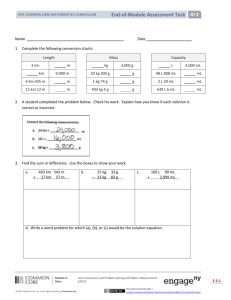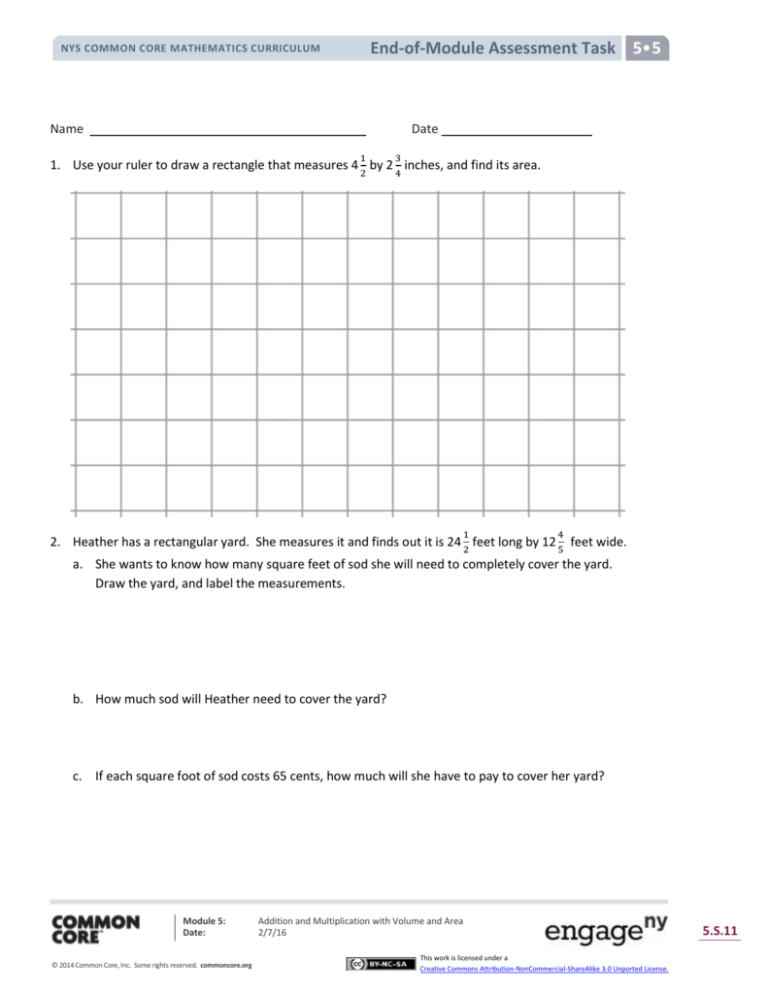
TaLesson
5•5
End-of-Module Assessment Task
•3
NYS COMMON CORE MATHEMATICS CURRICULUM
Name
Date
1
3
1. Use your ruler to draw a rectangle that measures 4 2 by 2 4 inches, and find its area.
1
4
2. Heather has a rectangular yard. She measures it and finds out it is 24 2 feet long by 12 5 feet wide.
a. She wants to know how many square feet of sod she will need to completely cover the yard.
Draw the yard, and label the measurements.
b. How much sod will Heather need to cover the yard?
c. If each square foot of sod costs 65 cents, how much will she have to pay to cover her yard?
Module 5:
Date:
© 2014 Common Core, Inc. Some rights reserved. commoncore.org
Addition and Multiplication with Volume and Area
2/7/16
This work is licensed under a
Creative Commons Attribution-NonCommercial-ShareAlike 3.0 Unported License.
5.S.11
NYS COMMON CORE MATHEMATICS CURRICULUM
TaLesson
5•5
End-of-Module Assessment Task
•3
3. A rectangular container that has a length of 30 cm, a width of 20 cm, and a height of 24 cm is filled with
water to a depth of 15 cm. When an additional 6.5 liters of water is poured into the container, some
water overflows. How many liters of water overflow the container? Use words, pictures, and numbers to
explain your answer. (Remember 1 cm3 = 1 mL.)
1
1
4. Jim says that a 2 2 inch by 3 4 inch rectangle has a section that is 2 inches × 3 inches and a section that is
1
2
inch ×
1
4
1
8
inches. That means the total area is just the sum of these two smaller areas, or 6 in2. Why is
Jim incorrect? Use an area model to explain your thinking. Then, give the correct area of the rectangle.
5. Miguel and Jacqui built towers out of craft sticks. Miguel’s tower had a 4-inch square base. Jacqui’s
tower had a 6-inch square base. If Miguel’s tower had a volume of 128 cubic inches and Jacqui’s had a
volume of 288 cubic inches, whose tower was taller? Explain your reasoning.
Module 5:
Date:
© 2014 Common Core, Inc. Some rights reserved. commoncore.org
Addition and Multiplication with Volume and Area
2/7/16
This work is licensed under a
Creative Commons Attribution-NonCommercial-ShareAlike 3.0 Unported License.
5.S.12
NYS COMMON CORE MATHEMATICS CURRICULUM
TaLesson
5•5
End-of-Module Assessment Task
•3
6. Read the statements. Circle True or False. Explain your choice for each using words and/or pictures.
a. All parallelograms are quadrilaterals.
True
False
b. All squares are rhombuses.
True
False
c. Squares are rhombuses, but not rectangles.
True
False
d.
True
False
True
False
The opposite angles in a parallelogram have the same measure.
e. Because the angles in a rectangle are 90, it is not a parallelogram.
f.
The sum of the angle measures of any trapezoid is greater than the sum of the angle measures of any
parallelogram.
True
False
g. The following figure is a parallelogram.
True
False
115
60
Module 5:
Date:
© 2014 Common Core, Inc. Some rights reserved. commoncore.org
Addition and Multiplication with Volume and Area
2/7/16
This work is licensed under a
Creative Commons Attribution-NonCommercial-ShareAlike 3.0 Unported License.
5.S.13
NYS COMMON CORE MATHEMATICS CURRICULUM
TaLesson
5•5
End-of-Module Assessment Task
•3
End-of-Module Assessment Task
Standards Addressed
Topics A–D
Apply and extend previous understandings of multiplication and division to multiply and divide
fractions.
5.NF.4
Apply and extend previous understandings of multiplication to multiply a fraction or whole
number by a fraction.
b.
5.NF.6
Find the area of a rectangle with fractional side lengths by tiling it with unit squares of
the appropriate unit fraction side lengths, and show that the area is the same as
would be found by multiplying the side lengths. Multiply fractional side lengths to
find areas of rectangles, and represent fraction products as rectangular areas.
Solve real world problems involving multiplication of fractions and mixed numbers, e.g.,
by using visual fraction models or equations to represent the problem.
Geometric measurement: understand concepts of volume and relate volume to multiplication and to
addition.
5.MD.3
Recognize volume as an attribute of solid figures and understand concepts of volume
measurement.
a.
A cube with side length 1 unit, called a “unit cube,” is said to have “one cubic unit” of
volume, and can be used to measure volume.
b.
A solid figure which can be packed without gaps or overlaps using n unit cubes is said
to have a volume of n cubic units.
5.MD.4
Measure volumes by counting unit cubes, using cubic cm, cubic in, cubic ft, and
improvised units.
5.MD.5
Relate volume to the operations of multiplication and addition and solve real world and
mathematical problems involving volume.
a.
Find the volume of a right rectangular prism with whole-number side lengths by
packing it with unit cubes, and show that the volume is the same as would be found
by multiplying the edge lengths, equivalently by multiplying the height by the area of
the base. Represent threefold whole-number products as volumes, e.g., to represent
the associative property of multiplication.
b.
Apply the formulas V = l × w × h and V = b × h for rectangular prisms to find volumes
of right rectangular prisms with whole-number edge lengths in the context of solving
real world and mathematical problems.
c.
Recognize volume as additive. Find volumes of solid figures composed of two nonoverlapping right rectangular prisms by adding the volumes of the non-overlapping
parts, applying this technique to solve real world problems.
Module 5:
Date:
© 2014 Common Core, Inc. Some rights reserved. commoncore.org
Addition and Multiplication with Volume and Area
2/7/16
This work is licensed under a
Creative Commons Attribution-NonCommercial-ShareAlike 3.0 Unported License.
5.S.14
NYS COMMON CORE MATHEMATICS CURRICULUM
TaLesson
5•5
End-of-Module Assessment Task
•3
Classify two-dimensional figures into categories based on their properties.
5.G.3
Understand that attributes belonging to a category of two-dimensional figures also belong
to all subcategories of that category. For example, all rectangles have four right angles
and squares are rectangles, so all squares have four right angles.
5.G.4
Classify two-dimensional figures in a hierarchy based on properties.
Evaluating Student Learning Outcomes
A Progression Toward Mastery is provided to describe steps that illuminate the gradually increasing
understandings that students develop on their way to proficiency. In this chart, this progress is presented
from left (Step 1) to right (Step 4). The learning goal for students is to achieve Step 4 mastery. These steps
are meant to help teachers and students identify and celebrate what the students CAN do now and what they
need to work on next.
Module 5:
Date:
© 2014 Common Core, Inc. Some rights reserved. commoncore.org
Addition and Multiplication with Volume and Area
2/7/16
This work is licensed under a
Creative Commons Attribution-NonCommercial-ShareAlike 3.0 Unported License.
5.S.15
NYS COMMON CORE MATHEMATICS CURRICULUM
TaLesson
5•5
End-of-Module Assessment Task
•3
A Progression Toward Mastery
Assessment
Task Item
and
Standards
Assessed
1
5.NF.4b
2
5.NF.4b
5.NF.6
STEP 1
Little evidence of
reasoning without
a correct answer.
STEP 2
Evidence of some
reasoning without
a correct answer.
STEP 3
Evidence of some
reasoning with a
correct answer or
evidence of solid
reasoning with an
incorrect answer.
STEP 4
Evidence of solid
reasoning with a
correct answer.
(1 Point)
(2 Points)
(3 Points)
(4 Points)
The student is unable
to draw the rectangle
and unable to find the
area.
The student draws one
dimension accurately
but is unable to find
the area.
The student accurately
draws both dimensions
of the rectangle but
makes a calculation
error when finding the
area.
The student correctly
does the following:
The student is able to
correctly perform two
of the following actions
in any combination:
The student correctly
does the following:
The student is unable
to draw the yard,
calculate the area using
appropriate units, or
calculate the cost of
the sod.
The student does one
of the following:
Draws and labels the
yard.
Calculates the area
of the yard with or
without the correct
units (square feet).
Finds the cost of the
sod.
Draws and labels the
yard.
Calculates the area
of the yard with the
correct units (square
feet).
Finds the cost of the
sod.
Draws the rectangle.
Calculates the area
3
as 12 in2.
8
Draws the yard and
labels correctly with
1
the length as 24 ft
2
and the width as
4
12 ft.
5
Calculates the area
of the yard using
appropriate units as
313
313
6
ft2 or
10
3 2
ft .
5
Finds the cost of the
sod to be $203.84.
3
5.MD.3
5.MD.5
The student is unable
to find the volume of
the water that has
overflowed and is
unable to explain the
reasoning used.
Module 5:
Date:
© 2014 Common Core, Inc. Some rights reserved. commoncore.org
The student finds the
volume of the water
that has overflowed
but is unable to explain
the reasoning used.
The student makes a
calculation error in
finding the volume of
the water that has
overflowed but is able
to clearly explain the
reasoning used.
The student finds the
volume of the water
that has overflowed to
be 1.1 L and uses
words, numbers, and
pictures to clearly
explain the reasoning
used.
Addition and Multiplication with Volume and Area
2/7/16
This work is licensed under a
Creative Commons Attribution-NonCommercial-ShareAlike 3.0 Unported License.
5.S.16
NYS COMMON CORE MATHEMATICS CURRICULUM
TaLesson
5•5
End-of-Module Assessment Task
•3
A Progression Toward Mastery
4
5.NF.4b
5.NF.6
5
5.MD.5
6
5.G.3
5.G.4
The student is not able
to draw an area model,
provide an explanation
of Jim’s error, or give
the correct area.
The student is neither
able to find the heights
of the towers nor able
to answer which tower
is taller.
The student provides a
combination of at least
three correct true or
false responses and/or
explanations.
Module 5:
Date:
© 2014 Common Core, Inc. Some rights reserved. commoncore.org
The student does one
of the following:
The student does two
of the following:
The student does the
following:
Accurately partitions
the area model in
both dimensions.
Accurately partitions
the area model in
both dimensions.
Accurately partitions
the area model in
both dimensions.
Provides a clear
explanation of Jim’s
error.
Provides a clear
explanation of Jim’s
error.
Calculates the
correct area of the
rectangle.
Calculates the
correct area of the
rectangle.
The student makes an
attempt to calculate
the towers’ heights but
makes errors in both
calculations.
Explanation of
reasoning used is
unclear.
The student calculates
the heights of towers
but makes a calculation
error that causes an
error in the
determination of the
taller tower. However,
the explanation of the
reasoning used is clear.
The student does the
following:
The student provides a
combination of at least
six correct true or false
responses and/or
explanations.
The student provides a
combination of at least
seven correct true or
false responses and/or
explanations.
The student provides
seven correct true or
false responses and
clear explanations for
all seven items.
Provides a clear
explanation of Jim’s
error.
Calculates the
correct area of the
rectangle as
8 1/8 in2.
Accurately calculates
the heights of both
towers (8 inches).
Explains clearly that
the towers are equal
in height.
a.
True
b.
True
c.
False
d.
True
e.
False
f.
False
g.
False
Addition and Multiplication with Volume and Area
2/7/16
This work is licensed under a
Creative Commons Attribution-NonCommercial-ShareAlike 3.0 Unported License.
5.S.17
NYS COMMON CORE MATHEMATICS CURRICULUM
Module 5:
Date:
© 2014 Common Core, Inc. Some rights reserved. commoncore.org
TaLesson
5•5
End-of-Module Assessment Task
•3
Addition and Multiplication with Volume and Area
2/7/16
This work is licensed under a
Creative Commons Attribution-NonCommercial-ShareAlike 3.0 Unported License.
5.S.18
NYS COMMON CORE MATHEMATICS CURRICULUM
Module 5:
Date:
© 2014 Common Core, Inc. Some rights reserved. commoncore.org
TaLesson
5•5
End-of-Module Assessment Task
•3
Addition and Multiplication with Volume and Area
2/7/16
This work is licensed under a
Creative Commons Attribution-NonCommercial-ShareAlike 3.0 Unported License.
5.S.19
NYS COMMON CORE MATHEMATICS CURRICULUM
Module 5:
Date:
© 2014 Common Core, Inc. Some rights reserved. commoncore.org
TaLesson
5•5
End-of-Module Assessment Task
•3
Addition and Multiplication with Volume and Area
2/7/16
This work is licensed under a
Creative Commons Attribution-NonCommercial-ShareAlike 3.0 Unported License.
5.S.20


